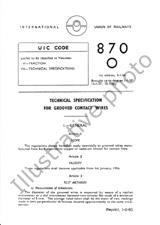We need your consent to use the individual data so that you can see information about your interests, among other things. Click "OK" to give your consent.

UIC B126/DT433-1ed.
Braking Questions - Composite brake block contour optimisation to reduce equivalent conicity - Synthesis of phase 1 results
Translate name
STANDARD published on 1.3.2013
The information about the standard:
Designation standards: UIC B126/DT433-1ed.
Publication date standards: 1.3.2013
SKU: NS-1190178
The number of pages: 130
Approximate weight : 421 g (0.93 lbs)
Country: International technical standard
Category: Technical standards UIC
Annotation of standard text UIC B126/DT433-1ed. :
Several investigations into the service performance of composite brake blocks have shown that these blocks produce a wear pattern on the wheel profile that is different from the wear pattern produced by cast iron blocks. One of the effects is the increase of equivalent conicity, which is a parameter used in assessing the running stability characteristics of a vehicle. Equivalent conicity changes relatively fast, especially on certain blocks made of sintered material.
In previous investigations the idea had arisen that the contour of the brake block had a significant impact on the wear pattern of the wheel profile and thus it was expected that modifying the block shape would have beneficial effects for the wheel profile. Therefore, in the beginning of 2009 UIC decided to start a project to optimise the shape of the brake block in order to prevent increases in equivalent conicity.
This report seeks to describe and summarise the activities carried out in the first phase of the project and draw some conclusions. The goal of the first phase was to check:
- whether the block shape did actually influence changes in the wheel profile, and
- whether bench tests were a suitable approach for the remainder of the project.
The approach consisted in conducting a certain number of bench tests with several block shapes and qualities, and compare the results with available service data.
"+
"
Name:Fragen des Bremswesens - Optimierung der Verbundstoffsohlenform zur Reduzierung der äquivalenten Konizität - Zusammenfassung der Ergebnisse von Phase 1|
Mehrere Untersuchungen der Betriebsleistung von Verbundstoffsohlen haben gezeigt, dass der Einsatz dieser Sohlen im Vergleich zu GG andere Radprofilverschleißmuster verursacht. Eine der Folgen ist der Anstieg der äquivalenten Konizität, ein Bewertungsparameter für die Laufruhe eines Fahrzeugs. Die äquivalente Konizität stieg insbesondere bei einigen geprüften Sintersohlen relativ schnell.
Frühere Untersuchungen ließen vermuten, dass die Sohlenform eine wichtige Rolle für das Verschleißmuster spielt. Man erwartete sich daher von der Änderung der Sohlenform positive Auswirkungen auf das Radprofil. Die UIC startete Anfang 2009 ein Projekt zur Optimierung der Bremssohlenform, um den Anstieg der äquivalenten Konizität zu verhindern.
Der vorliegende Bericht beschreibt zusammenfassend die Aktivitäten der ersten Projektphase und zieht einige abschließende Schlussfolgerungen. Ziel der ersten Phase war es zu prüfen, ob:
- die Sohlenform tatsächlich einen Einfluß auf die Radprofilentwicklung ausübt,
- die Prüfstandversuche eine geeignete Methode für die Weiterführung des Projekts darstellen.
Dies wurde anhand einer Reihe von Prüfstandversuchen mit verschiedenen Sohlenformen und -qualitäten und durch den Vergleich mit verfügbaren Betriebsdaten ermittelt.
"+
"
We recommend:
Technical standards updating
Do you want to make sure you use only the valid technical standards?
We can offer you a solution which will provide you a monthly overview concerning the updating of standards which you use.
Would you like to know more? Look at this page.



 Cookies
Cookies
